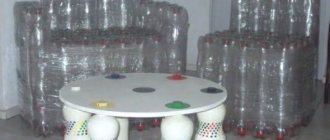Greenpeace has long been concerned that plastic waste has become an environmental scourge around the world in recent decades.
Today there are many craftsmen who are ready to show master classes on the use of waste materials in the creation of various buildings that are so necessary on private plots. One of the options for using plastic bottles is warm, reliable greenhouses and greenhouses. The main trump card is that such buildings are almost free!
What you need to know about greenhouses
Purpose
Like a greenhouse, a greenhouse is used to create a favorable microclimate when preparing seedlings or when fully growing tomatoes, cucumbers, cabbage and other plants.
In a broad sense, both structures are perceived as the same thing, although in fact a greenhouse is a small and unheated structure. A greenhouse is a larger building with a heating and ventilation system, which allows for the cultivation of many crops at any time of the year.
Design
The structure of greenhouses is quite simple. A frame is assembled from pipes, metal or wood, which is covered with film, polycarbonate, glass, acrylic and other light-penetrating materials. If the weight of the structure is very large, it is additionally installed on the foundation.
For ventilation, removable panels or opening transoms are provided. Heating is carried out using water heating with radiators, infrared heaters or hot air from heat sources outside the greenhouse.
Installation
Since sunlight is vital for plants, the greenhouse should be built on the south side. It is advisable to place it on a slope and closer to other buildings in order to protect it from the wind and have access to utilities. It is better to stay away from high fences and trees: they provide shade, and falling leaves reduce light transmission.
Greenhouse for tomatoes and cucumbers
The basic principle of this type of design is to alternate bottles with colored and transparent plastic, resulting in a semi-darkening effect, which has a beneficial effect on the growth of cucumbers and tomatoes.
- First you need to select a suitable rail so that it matches the height of the entire structure.
- Plastic plates, pre-made from bottles, are attached to the slats using a furniture gun. It is important that the workpieces are the same size.
- You can also place a film on the inside for greater reliability and insulation.
How to make a greenhouse with your own hands from agrofibre and reinforcement
youtube.com
- Assembly complexity: low.
- Foundation: not required.
- Cost: low.
- Variations: the frame can be replaced with plastic pipes, and the covering material with film.
The simplest design option, which is ideal for a small greenhouse. A frame made of reinforcement is installed directly on the bed, and agrofibre or, as it is also called, spunbond, is stretched over it. This material protects from the sun while retaining heat and moisture.
1. The dimensions of such a greenhouse are chosen arbitrarily, depending on the footage of available materials. For example, it is convenient to cut six-meter reinforcement in half. With such a length of arcs, the width of the greenhouse is about 80 cm. The arcs themselves should be installed in increments of 1.2–1.5 m.
teplica-exp.ru
2. Arcs are bent from reinforcement with a diameter of 8 mm. Next, drip irrigation tubes or an old hose are put on them, leaving 10–20 cm at each end so that it is convenient to insert the structure into the ground.
ebayimg.com
3. After marking the installation locations for the arcs, scraps of steel pipes or drilled wooden pegs 20–30 cm long are driven into the ground, and the reinforcement is inserted into them.
stopdacha.ru
4. Spunbond can be stitched on a sewing machine, forming pocket folds that fit directly onto the arches. Another option is to install plastic pipe guides on the sides of the beds and attach agrofibre to them using purchased clips or cut pieces of pipes. The covering material can eventually be easily lifted by simply removing them.
stblizko.ru
5. If desired, you can attach the arcs not to pipes driven into the ground, but to metal guides rigidly fixed at the edges of the base. This design will allow you to fold the greenhouse like an accordion, simply by moving the arcs.
must.kz
6. The free ends of the spunbond at the ends must be collected, tied in a knot and secured with a peg, earth or other means.
samara.kinplast.ru
Here are step-by-step video instructions.
Strange choice? Not at all
Plastic bottles are made from polyethylene terephthalate (PET). It is absolutely neutral and suitable for drinking liquids.
A PET bottle is such a multifunctional thing
Plastic bottles are an inexhaustible storehouse for various crafts; single bottles are used as flower pots and tiny “greenhouses” for seedlings. Drainpipes are made from a large number of them. And sometimes - a serious engineering structure: deep drainage on the site. Our “Kulibins” went further and came up with a new use for bottles: fences and greenhouses. Moreover, everyone has a lot of empty bottles, and you can always ask friends and neighbors to throw more.
Application options for plastic bottles (photo gallery)
Mini-greenhouses made from plastic bottles
Drip irrigation using plastic bottles
Growing flowers using plastic bottles
Crafts from bottles - table lamps
Flowerpot made from a bottle and several bottle bases
Bottle drainpipes
The trench with bottles is prepared for filling with drainage material - there will be deep drainage of the area
A greenhouse made from bottles is durable, strong, easy to assemble, requires no maintenance, incredibly cheap, and its components are easy to replace. And most importantly, it is much warmer than its “competitors”. Because everyone knows from a school physics course: air is the best heat insulator, and bottles create the effect of a thermos.
There is simply no warmer greenhouse like this. Experienced gardeners assure: for early sowing and growing seedlings even in cold weather, there is no need to additionally heat the greenhouse from bottles from the inside.
Now let’s decide what we should call the future structure.
How to make a greenhouse with your own hands from masonry mesh and film
dachadecor.com
- Assembly complexity: low.
- Foundation: not required.
- Cost: low.
- Variations: instead of film, you can use agrofibre, and make the door on a wooden frame.
A budget option for a greenhouse made from masonry mesh and regular film, which is quickly assembled and has a number of advantages. The design does not require a foundation; due to its elasticity, it is resistant to wind loads, and is also convenient for tying up plants from the inside. At the same time, by folding the mesh, you can get different sizes depending on your needs.
- Wooden beams, steel angles, pipes or channels are used as load-bearing posts. They are hammered at a distance of 1.2–1.4 m.
- The greenhouse arch is formed from two pieces of mesh laid overlapping. From below it is attached with wire to the posts, and from above it is fastened together with the same wire or plastic ties.
- To strengthen the structure, T-shaped supports made of wooden beams 50 × 50 mm are installed in the middle of the passage. If desired, they can also be driven into the ground.
- A film is put on a dome assembled from a mesh, which is held in place by strings of twine or rope stretched over it.
- The side walls are also made of film, which is folded up and attached to the dome with tape. In several places at the top and bottom, small windows are cut for ventilation of the greenhouse.
- The door is made on a wooden frame or made from the same film, which is cut and attached to the side wall with magnets in the manner of door mosquito nets.
How to make a greenhouse with your own hands from stretch film with a wooden frame
stroydachusam.ru
- Assembly difficulty: average.
- Foundation: not required.
- Cost: low.
Another way to quickly build a greenhouse. A wooden beam is used as a frame, and stretch packaging film is used as a covering material. With a large number of layers, it transmits light a little worse than ordinary PVC film, but on hot days this is even a plus.
- The film is sold in rolls, so the dimensions of the greenhouse are selected according to the cutting of the timber and taking into account your wishes.
- For the base, steel corners 40 × 40 mm are used, in which holes for attaching the frame posts are pre-drilled. They can also be treated with bitumen or painted to extend their service life.
- The corners are driven into the ground, and pieces of timber are screwed to them with self-tapping screws. A lower frame, in turn, is attached to the beam, on which the side walls and roof are assembled. All corners are reinforced with additional inclined sections of timber.
- The door is assembled on a wooden frame in one of the side walls and installed on hinges.
- Film wrapping is done in parts, in several layers and overlapping. First, the gables are installed, then the roof slopes, and only then the walls. You need to start wrapping them from the bottom so that running rainwater does not get inside the greenhouse.
- After wrapping with glazing bead or river, the door and its outer contour of the door are trimmed, and then the film around the frame is cut through. In the same way you can make a window in the opposite wall.
Preparatory work
In order to make the simplest greenhouse by hand, it is necessary to carry out the necessary preparatory measures.
When choosing a location for a greenhouse, you should be guided by the fact that there is no interference with direct sunlight. The site should be as level as possible, and it is advisable to have protection from strong winds.
News site- Features of electrical wiring installation in houses made of SIP panels
- How to choose a cast iron bath
Please note that you will need water for irrigation and electricity for lighting. Therefore, the greenhouse should be located on the site within acceptable proximity to these sources.
How to make a greenhouse with your own hands from old window frames
teplica-piter.ru
- Assembly difficulty: average.
- Foundation: desirable.
- Cost: minimal.
- Variations: you can combine frames with film to make a roof, side walls or doors.
The main advantage of this design is its low cost. Old window frames can be found, if not free, then for a nominal price. In addition, glass transmits light much better than film and polycarbonate. The windows already have vents for ventilation, and if you select a balcony block, you will also have a ready-made door.
- The size of the greenhouse depends on the size of the frames and the interior space you need. Aim for a width of about 2.5 m to give a passage of about 60 cm and two beds of 80–90 cm.
- Windows and glass have considerable weight, so it is advisable to install them on a solid base. This can be a shallow strip foundation, a massive wooden beam or a metal profile.
- A wooden frame or pillars are installed on the foundation at the corners, and frames are attached to them and to each other. The gaps between each block are covered with putty and clogged with strips of laminate backing or a thin wooden strip.
- A door is made in the front wall. Its role can be played by one of the windows, a balcony door or a wooden frame covered with film. Ventilation is provided through window vents.
- To reduce weight, it is better to make the roof from wooden beams and film. You can use the same window frames, but in this case you will have to reinforce the structure with supports in the middle of the passage so that it can withstand a lot of weight.
What to cover
The main covering material for greenhouses and greenhouses is film. It is used on both small and large-sized structures. Glass was previously used for year-round use, but its high price and fragility led to the fact that it is used very rarely - the resulting shelter is expensive. And the large weight of the glazing requires a solid frame.
There are two new items. The more familiar polycarbonate, which is used for gazebos and canopies, and the relatively new one is spunbond non-woven covering material.
Now about everyone in more detail.
Film for greenhouses and greenhouses
Available in different polymers and different thicknesses. The most common are polyethylene and polyvinyl chloride. There are also reinforced ones.
Polyethylene films are the most inexpensive, but they are also the most short-lived. Even with the most careful treatment, they do not last more than a year: they become fragile under the influence of ultraviolet radiation, and the cold kills them. However, they are most often bought: cheap.
Available in sleeve form. By cutting it on one side, we get double width. There is no point in using uncut film: the service life will remain the same, but the consumption will be exactly twice as much. There is only one feature: the film breaks quickly along the fold. It is difficult and almost useless to seal it afterwards: the tape sticks very poorly to a dusty surface. Therefore, this fold is taped with tape before use. It turns out reliable.
Thickness and types
The optimal thickness of polyethylene film for summer cottages and greenhouses is 150 microns. If you take a thicker one, its service life will still be one season, but 150 characteristics will be enough.
The reinforced film differs in appearance: the cage is clearly visible
Reinforced film is more durable. Manufacturers provide a 3-year warranty. It is easy to distinguish by its appearance: it is checkered. Fibers of other polymers or the same polyethylene, but processed differently, are woven into polyethylene fabric. Thanks to stronger fibers, such a film greenhouse can withstand wind and snow loads well (to a certain extent). Reinforced film is available in different densities; for greenhouses and greenhouses at dachas and personal plots, 120 g/m2 to 200 g/m2 is more suitable.
There are also polyvinyl chloride films. They can be used for up to 7 years. But they are expensive. The material is also good because it transmits sunlight well (80-90%) and almost does not transmit infrared light (5-10%), that is, it does not allow the greenhouse to cool down overnight. If you need a warm greenhouse that maintains temperature well at night, this is your choice.
There are also films called perennial. Most often it is polyethylene with various additives. Some other polymers are less common. Typically, perennial films have some special properties:
- less destroyed by ultraviolet radiation - light-stabilizing;
- transmits less thermal radiation - heat stabilizing;
- prevents condensation drops from forming on the film - hydrophilic;
- reflects thermal radiation, glows in the dark, absorbs ultraviolet light - these properties depend on the type of additives, but are called light-converting.
These properties can be combined in one film. This is how you can find a long-term hydrophilic heat-stabilizing film, etc. One more thing. Such films usually have some kind of tint: yellow, greenish, blue...
Perennial films have different colors
When choosing a multi-year film, be sure to check its service life. It can be from two seasons to 3 years. Note. If it says 2 seasons, it means it needs to be removed for the winter. If 2 years, then this is a film for year-round use. Sellers often manipulate these concepts, saying that two seasons mean two years.
See photo reports on the construction of greenhouses with your own hands here.
Polycarbonate
This cellular material has many advantages: it is lightweight, transmits light well, retains heat, bends, and is easy to install. The disadvantage is the relatively high cost. However, if the greenhouse will be used for more than one year, such investments will pay off: even without additional heating, the growing season will increase significantly.
But polycarbonate varies in structure and thickness. The most commonly used types in the construction of greenhouses are in the table.
The structure of polycarbonate and its thickness
For normal conditions (average snow load and wind), single-chamber sheets are used to cover greenhouses. For regions with a lot of snow, it makes sense to take reinforced ones.
The optimal thickness of the sheets is 6 mm or 8 mm. You shouldn’t take less: the sheets are too fragile and their characteristics are not very good (see table). Polycarbonate 4 mm thick can be placed on small greenhouses. It will not withstand heavy loads.
Characteristics of polycarbonate of different thicknesses
Polycarbonate still needs to be fastened correctly: the cells must be oriented from top to bottom, the open edges must be sealed with a special tape or tape, secured with special thermal washers or bolts with a large metal washer, under which a rubber or plastic lining must be placed.
Spunbond
This is no longer the same material. There are many brands: Agril, Lutrasil, Spantex, Agrospan, AgroSUF, etc. It’s just that Spunbond appeared first and now all similar materials are called that way, and also “non-woven covering material” or “agrofibre”. This is a non-woven polypropylene fiber that has unique characteristics: it allows air, light and moisture to pass through, while simultaneously saving plants from overheating or freezing. Feedback from a practice on using this material in a video.
Agrofibre is characterized by density. The lowest is 17 kg/m3, the highest is 60 kg/m3. For seasonal greenhouses and greenhouses from spring to autumn, the optimal density is 30-40 kg/m3; for winter ones, 60 kg/m3 is needed.
Read about how to organize drip irrigation here.
How to make a greenhouse with your own hands from film and polypropylene pipes
maja-dacha.ru
- Assembly difficulty: average.
- Foundation: not required.
- Cost: low.
- Variations: the film can be replaced with agrofibre or polycarbonate
A greenhouse made of polypropylene pipes attracts with its simplicity, reliability and low price. The materials are sold at any hardware store, and assembly does not require any special skills or tools. You can even do without a soldering iron if you connect the pipes not with fittings, but with through bolts.
- As always, sizes are selected based on needs and available materials. Polypropylene pipe is usually sold in 4 m sections, and it is easy to cut and splice using couplings.
- The first step is to calculate the length of the pipe and the number of fittings required. It’s better to take it with a reserve so that you don’t have to run to the store later.
- The main parts are soldered from pipes, tees and crosspieces - arches with crossbars and longitudinal inserts.
- Next, the greenhouse is assembled from the prepared parts. If a soldering iron is not at hand, you can use bolts with nuts and washers to connect, which are inserted into pipes drilled through.
- The film is secured to the edges of the frame using purchased pipe clamps or homemade clips made from slightly larger diameter pipes cut along sections.
Preparing plastic bottles
Before starting the construction of the greenhouse, the blank material must be prepared. To achieve this, a number of activities are carried out:
- To begin with, the bottles need to be sorted according to certain parameters, such as color and volume. It is not necessary to divide plastic into green, brown and transparent; color or colorless sorting is enough. It is necessary to be precise with the volume so that there are no difficulties during assembly.
- Each container should be cleaned: remove labels and adhesive layer. To do this, they need to be placed in water and left for 2-3 days. Thanks to this procedure, the containers are disinfected, and the remaining glue is easily separated.
- After cleaning, they should be tested outdoors for a few days. This is done to ensure that all unpleasant and chemical odors disappear.
This procedure is time-consuming, since it is necessary to carefully process each of the 2000 containers, so it is carried out gradually, as the necessary materials are acquired. After completing the preparation of plastic blanks, you can begin construction.
How to make a greenhouse with your own hands from film with a wooden frame
legkovmeste.ru
- Assembly difficulty: average.
- Foundation: not required.
- Cost: low.
- Variations: the film can be replaced with agrofibre or polycarbonate.
A classic version of a greenhouse, used for decades and not losing popularity. Wooden beams are easy to process, have low weight and sufficient strength, and also retain heat well. The structure does not require a capital foundation - you can get by with a frame made of timber of a larger cross-section or use steel corners as a base.
- The standard cutting of timber is 6 m, so they start from this figure. Most often, greenhouses are made 3 × 6 m, but if desired, the dimensions can be either reduced or increased. The finished project with material calculations is available at this link.
- The assembly of the frame is the same as for a greenhouse made of stretch film. Steel corners are driven into the ground at intervals of about 1 m at the points where the posts are attached. In each of them, two holes are drilled for self-tapping screws or one for M8 or M10 bolts.
- Vertical posts are fixed to the corners along the entire perimeter, which are tied with an upper contour made of timber. To add rigidity in the corners, one jib is added on each side
- Triangular roof trusses are installed and secured opposite the racks. The slope angle is selected depending on the snow load. So, if there is a lot of snow in your region, the angle of inclination should be greater (the roof is higher and sharper).
- The door and window for ventilation are assembled on wooden frames and installed in the front and rear walls, respectively.
- At the end, the frame is covered with film, which is attached to the beam using a lath stuffed on top. All sharp parts on the wood are rounded off or covered with a soft material so that the film does not tear during operation.
Video description
The video shows a comparison of an attached and a free-standing greenhouse:
The advantage of this option is the reduction in material costs due to that very wall. It is important to attach the frame to its plane as much as possible, making the joining points strong and reliable.
As for materials, there are no restrictions here either. All of the products described above can be used to assemble a frame structure. And such a greenhouse can be covered with films, glass or polycarbonate.
Greenhouse attached to the wall of the house Source pinterest.com
How to make a polycarbonate greenhouse with a metal frame with your own hands
- Assembly difficulty: high.
- Foundation: required.
- Cost: high.
- Variations: the foundation can be made of wooden beams or use steel reinforcement, angle or pipes driven into the ground.
The most popular and modern version of the greenhouse. This design is much more expensive than others and is difficult to manufacture, but it will last for decades. Polycarbonate can withstand the open sun for 10–12 years, and the frame made of a profile steel pipe is almost eternal.
1. The standard size of polycarbonate is 2,100 × 6,000 mm, so it is convenient to cut it into four or two parts with dimensions of 2.1 × 1.5 m or 2.1 × 3 m, respectively. Such pieces will be optimal for a greenhouse measuring 3 × 6 meters.
2. For reliable fastening and distribution of wind loads, a foundation is made under the greenhouse. This can be a shallow strip foundation, a frame made of antiseptic-treated wooden beams, or steel corners driven into the ground.
YouTube channel of Evgeniy Kolomakin
3. The design of the greenhouse consists of an arch, which is formed using arcs from a profiled steel pipe 20 × 20 mm, located at a distance of one meter from each other.
4. The arcs are fastened together by longitudinal sections from the same pipe, which are connected by welding.
5. A door is installed at the front end: a frame measuring 1.85 × 1 m is welded from a pipe, which is attached to the frame on hinges. A window for ventilation measuring 1 × 1 m is made according to the same principle and is located at the rear end.
6. Covering with polycarbonate begins from the ends. The sheet is cut in half, attached to the profile using special self-tapping screws with thermal washers, and then trimmed along the contour of the arc with a sharp knife. After this, the side wall sheets are installed.
How to make a polycarbonate greenhouse with a galvanized profile frame with your own hands
techkomplect.ru
- Assembly difficulty: average.
- Foundation: not required.
- Cost: low.
A simpler and more affordable option for a polycarbonate greenhouse. It does not use expensive metal pipe that needs to be welded. And galvanized profiles for plasterboard systems are used as frame material. They are easily cut with metal scissors and fastened with ordinary self-tapping screws.
- When choosing sizes, as usual, we start from the parameters of polycarbonate sheets. Since the profiles lose rigidity when bent, it is better to choose a gable greenhouse rather than an arched one.
- By analogy with arches made of a metal pipe, a frame made of galvanized profile is assembled from ribs in the form of a house.
- The assembled modules are installed on a frame made of wooden beams and tied together with sections of profiles. Doors and a window for ventilation are made in the front and rear walls.
- At the end, the frame is sheathed with polycarbonate sheets, which are secured using special self-tapping screws with plastic thermal washers.
Wall mounted
Such greenhouses are good because they can be used in winter without major financial investments, since it is not at all difficult to organize the flow of heat into the greenhouse directly from home.
Please pay attention to one important point - wall structures must be installed on the south side (this is important!).
Greenhouse fence
Can act as a stand-alone fence or in combination with an existing fence.
This option attracts many summer residents because it allows not only to save space on the site. You can also save on materials, which, of course, is good news.
Thermos
One of the most successful options for use in winter. This design allows you to grow vegetables even in severe frosts.
Underground
Such structures are buried 1.5-2 meters into the ground. The coating most often used is polycarbonate.
When using such a greenhouse in winter, there is usually no need to install heating equipment. But the costs of its construction are still considerable.
How to make a glass greenhouse with a metal frame with your own hands
juliana.ru
- Assembly difficulty: high.
- Foundation: required.
- Cost: high.
- Variations: to make the structure lighter, you can make the top from polycarbonate or film.
The most correct, but rather labor-intensive and expensive option for a greenhouse. The main advantage of glass is its excellent light transmittance and durability. However, due to the heavy weight of the structure, a strong metal frame and foundation are required. In addition to arranging a strip foundation, the difficulty also lies in the need to use welding.
- When it comes to choosing sizes, a glass greenhouse is no exception - everything is strictly individual and taking into account the available materials.
- The impressive weight of glass and metal frame requires a full foundation. Usually a trench 30 cm deep and 20 cm wide is dug around the perimeter, wooden formwork 20 cm high is installed on top and the whole thing is filled with concrete. Also, before pouring, anchor bolts are inserted into the formwork to secure the frame.
- A metal channel or corner is attached to the resulting base using anchors. Then racks 1.6–1.8 m high are welded to this frame from two folded corners 45 × 45 mm. At the top they are fastened with longitudinal sections of the corner.
- Next, rafters from the same double corners are placed on the resulting box. At the bottom they are welded to the posts, and at the top - to another corner, which acts as a ridge beam.
- A door is inserted into one of the walls, and a window is installed in the lid or wall for ventilation.
- The glass is installed in the frames obtained by using double corners and secured with homemade gluers - thin aluminum or steel plates bent in the shape of the letter Z. The gluer is attached to the corner with one hook, and to the glass with the second.
Foundation
The type of greenhouse chosen determines its foundation. First, markings are made - the sides form a right angle. For a seasonal structure, a wooden base made of timber (10x15 or 15x15 cm) treated with an antiseptic or water-repellent compound is suitable to last longer. Place it on the ground, but preferably on a cushion of compacted sand or on concrete slabs.
For a permanent building you will have to dig a pit. You can make a strip foundation - a trench 30x30 cm. Sand is poured onto the bottom, crushed stone on top (all 50-70 cm thick). They put up formwork from boards, lay roofing felt and fill it with concrete. It needs to be pierced with a shovel and knocked on top to remove the air. The base is raised above the ground by 20-50 cm. Support posts or pieces of metal corners are embedded in the foundation.
How to make a dome greenhouse with your own hands from film with a wooden frame
pinterest.com
- Assembly difficulty: high.
- Foundation: desirable.
- Cost: high.
- Variations: the film can be replaced with polycarbonate or glass, and the frame can be made of profiles or pipes.
A domed or geodesic greenhouse attracts primarily with its unusual appearance: it consists entirely of many triangles and hexagons. Other advantages include high structural strength and best light transmittance. The geodesic dome has only one drawback: it is difficult to manufacture.
- The dimensions of such a greenhouse are selected individually, based on the required area. Since the frame design is quite complex, calculations are the most time-consuming part of the project.
- In order not to get confused and take into account all the nuances, it is convenient to carry out the calculation using a special calculator. In it you can set the dimensions, select the “thickness” of the frame and get a list of all the necessary parts for assembly with dimensions, as well as their approximate cost.
- Regardless of its dimensions, a domed greenhouse is highly durable and is not afraid of winds, so there is no need to make a foundation for it. However, since the construction of a structure is very labor-intensive, it is rational to extend its service life and equip a lightweight strip foundation for attaching the frame.
- The ribs of the structure consist of triangles, which, in turn, are assembled from a wooden batten according to a template. First you need to prepare the required number of such triangles.
- The greenhouse is assembled like a magnetic construction set from childhood. Starting from the bottom, rows of triangles are assembled one after another, which are fastened together using self-tapping screws and form a dome. If everything is calculated correctly, it will close at the top and will be perfectly shaped.
- One of the triangles in the roof is made folding or removable to provide ventilation. The door is either installed in a polygon shape, or made in a traditional shape with a mortise frame.
- The film covers the finished dome or is stretched over each triangle at the assembly stage. In the first case, it will be easier to replace the film when it breaks. The second one gives a more aesthetic appearance. Which one to choose - decide for yourself.
Required Tools
During the construction of a greenhouse, from measuring the site to installing the frame and assembling the main part, it is necessary to prepare special tools in advance:
- construction awl;
- cutter;
- hacksaw for wood and metal;
- hammer;
- nails of various sizes;
- nylon thread and copper wire;
- tape measure and measuring tape;
- level;
- pencil, paper, ruler;
- plastic bottles;
- wooden beams;
- mounting rail.
At various stages of construction, the need for certain tools will arise, so it is important to organize the workplace well.
When building, it is necessary to wear protective gloves to avoid damaging your hands; it is also advisable to wear special overalls and goggles when working on wood to prevent sawdust from getting into your eyes and clothes. In addition, you should always have a first aid kit on hand in case of unforeseen circumstances.











